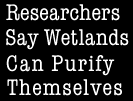

| Volume One, Issue Nine |
|
Last updated June 15, 1996 |

Researchers have reported that they may be able to design wetland systems that can naturally purify water. Civil and environmental engineers from the University of California at Berkeley and Northwestern University in Evanston, Ill., found that human-developed wetlands reduced levels of nitrates and chlorinated organic compounds. Microbes in a 250-foot section of artificial wetlands along the Santa Ana River in Orange County that had been planted with cattails removed nitrates at a significant rate, and open water that had been naturally inundated with duckweed recorded denitrification at a lower but still-impressive level. Nitrates in drinking water are hazardous to health in humans, and chlorinated organic compounds may be linked to cancer.
Related Sites Artifical Wetlands Capable of Reducing Pollutants: Science Daily Recognizing Wetlands: An Informational Pamphlet Sierra Club: Why Wetlands Are Good 
In the April issue of "What's New" we ran a story on a free NASA CD-ROM. This month we are happy to inform you about another one. This CD-ROM, "Perspectives on an Ocean Planet," focuses on the TOPEX/POSEIDON oceanography mission. The CD-ROM works on post Macintosh and PC platforms and contains digital video, audio, images, and other information on the TOPEX/POSEIDON mission. Check it out.
The CD can be ordered free at:
"What's New in in the World of Science" is published the middle of every month. Remember to check back next month and see "What's New"!
|

This picture is the first global X-ray image ever obtained of the Earth's aurora.
The photographs of the aurora borealis (or "northern lights"), captured by the satellite Polar, are considered the best ever obtained from space.
The aurora borealis and the aurora australis, its counterpart in the southern hemisphere, are caused when electrons and protons ejected by the sun (the "solar wind") are captured by Earth's magnetic field.
These charged particles collide with oxygen and nitrogen atoms, and the resulting ions (atoms charged by the loss or gain of electrons) emit radiation at wavelengths that create the characteristic brilliant streaks of light.
"What's New" asked NASA scientist Dr. Robert A. Hoffman to explain the significance of auroras.
Click
HERE
to download the RealAudio player.
Here's a strange one to try. Go out and buy a roll of wintergreen-flavored Lifesavers (in the green roll). Find a room that can be made totally dark and take a mirror with you (or use the bathroom at night.) Sit in the dark to allow your eyes to adapt and then bite down on a Lifesaver while looking in the mirror. The Lifesaver will spark and glitter as you chew! (Don't worry; you can't get a shock, only cavities.)
Certainly, this is one of the more unusual ways to make light. The process of light created by friction is called "triboluminescence" (from the Greek "tribein," meaning "to rub," and the Latin prefix "lumin-," meaning "light".) When you crush certain crystals, large electric fields can be created as the crystal is stressed. Sometimes the electric field is strong enough to rip the outer electrons from their parent atoms. Eventually, the atoms get back together with their lost electrons and give up energy in the form of light. In particular, when nitrogen atoms are ripped apart and recombine, they give off light in the ultraviolet, violet, and blue parts of the spectrum. This is what you see. The wintergreen Lifesavers are the best because the wintergreen oil (methyl salicilate) is fluorescent and converts the ultraviolet light (which is invisible) into visible blue light, adding to the effect. The ripping apart and recombination of nitrogen atoms is what makes the aurora borealis glow, so in a sense, you have a mini-aurora in your mouth.
If you unroll masking tape in the dark, you may see the same blue glow at the joint where the tape is unsticking from itself. Note that this does not work with all masking tape and doesn't work at all with "Magic Mending Tape."
|

|

|

|
| The Learning Studio | The Exploratorium |